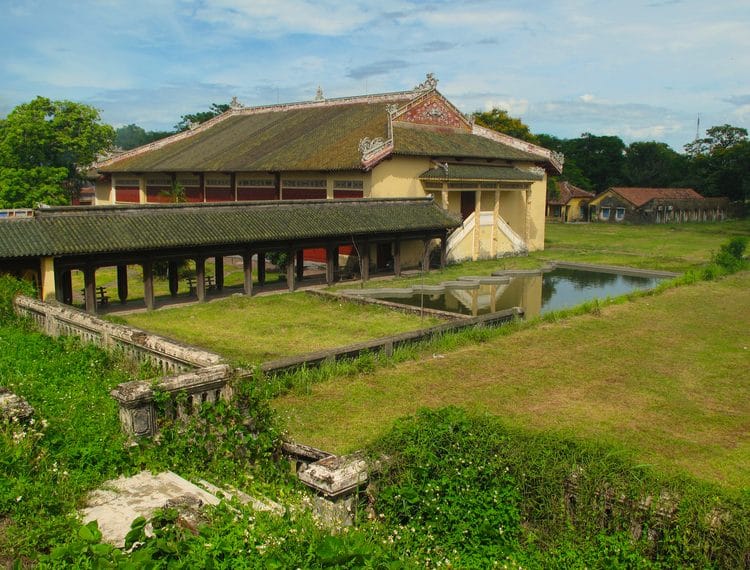Hue is renowned for the great architectures of the Nguyen Dynasty. Among these monuments, Duyet Thi Duong, the oldest theater in Vietnam, is a fascinating destination for foreigners and history lovers.
Location and its meaning:
Duyet Thi Duong lies on the eastern of Quang Minh Palace in Forbidden City, Thua Thien Hue province. Duyet Thi Duong was the court theater and constructed in the period of Emperor Minh Mang, 1826. According to translation, the word “duyệt” means “consider to distinguish “wrong and right”, while “thị” means “watch” or “see”, and “đường” means “house”. This place was originally used for serving Tuồng performances (classical drama) for kings, royal family, mandarins, guests and envoys. Tuồng performed in Duyet Thi Duong was usually classical court drama and very much in vogue.
Construction History And Restoration:

Duyet Thi Duong was in restoration for many times in Nguyen Dynasty’s Kings. In 1962, Vietnam government restored and repaired Duyet Thi Duong for the teaching location of Hue national music school. The surrounding buildings were removed to make space for building teachers and students’ accommodations. As a result, the structure of Duyet Thi Duong fundamentally changed a lot. Due to war, disasters and people’s unawareness, Duyet Thi Duong was seriously downgraded. From 1995 to 2002, the theater was renovated and remade for the last time and was officially opened in March 2003. The aisles of guests and mandarins in the past are now repaired to serve tourists.
Since 2004, Duyet Thi Duong has been restored and put into operation by Hue Monuments Conservation Centre to serve tourists with Hue Royal Court Music genre (Nhã nhạc cung đình Huế) that was attractive to visitors. The theater collected and restored eight of eleven ancient dances, 40 court music songs and many extracts of classical drama. Of the restored performances, there were a large number of parts set in the scene meticulously, featuring Thái Bình drum, Tam luân cửu chuyển, Kim tiền, Phú lục địch, Vũ Phiến, Lục Cúng Hoa Đăng and extracts of classical drama such as Kỷ Lan Anh, Ôn Đình chém Tá. Besides, the theater creates and arranged tens of artwork which still bears the ancient characteristics and is eminently suitable to the audience’s predilection. Among those performances, “Người khởi nghiệp đàng trong” (it can be loosely translated into “starting a business in the region of Central Vietnam”) was highly appreciated by the public.
Layout:

With the total area of 11.740 square meters and the theater’s 1.182 square meters, Duyet Thi Duong had the whole campus for planting rare Vietnamese medicinal herbs. On the right of the theater was Ngự Y institute – where to process medicines for the King and royal family. On the left was Thuong Thien department – where to cook meals to serve the king. A wall separated all of these locations and the theater.
The theater was a large rectangle shape with the roof which had curved edges as Hue temples and pagodas and was propped by two ranges of vermilion wooden iron pillars along with dragons hidden in clouds. In the middle of each pillar was hung a landscape painting about Hue with a dragon carved. Upper the pillar was the sun, the moon and stars symbolizing for the universe that were painted or carved in the blue ceiling. The building was interconnected with the palace of King by a line of lobby and a winding and curving roof.
The square stage was placed in the middle of the floor. The wall at the end of the stage had two doors. Actors and actresses must come on the stage on the right side and go out on the left side. Behind the wall, there was a large room to store facilities, clothes for performances. In the highest location of the room was the altar of two founders of classical drama. The door of this room was built towards the yard of the eastern Forbidden City (artists would enter this path).
There, a platform which was divided into two steps was symmetrical to the wall across the stage. The higher stage is laid next to the western of the wall for the queen and imperial maids, and the lower stage was put seats for the king to watch performances. Two stages were separated by a thin fence of bamboo flutes, which made people inside look the audience clearly, but the audience could not see clearly the face of anyone inside. Sometimes, they just heard the sound of the fan waving softly as the giggling smile inside the fence. Two sides of the King’s seat were placed several sets of tables and chairs for statesmen. In the French colonist, governors-general or French Resident Superiors usually sat there.
Opening time:
Duyet Thi Duong is now immensely popular with tourists by its restoration of classical drama in the past hundreds of years. Therefore, tourists want to experience tuồng performances and discover the history of the oldest Vietnamese theater, you can come in the opening time. It is often performed at 10:00-10:35 am and 3:00-3:35 pm. The ticket price is posted in the ticket stall. Coming to Duyet Thi Duong, tourists will admire the unique fork art of Vietnam, which has been well-preserved from generations to generations.
By Minh Phuong















